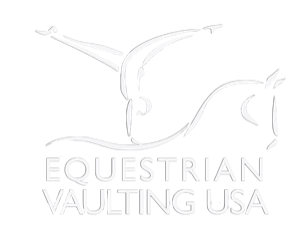Lunging Criteria
Lunging Criteria

Photo courtesy Andrea Selch
Lunging counts for 15 percent of the horse score. The lunger should have experience both as an equestrian and as a vaulting lunger. The lunger is responsible for controlling the horse, helping the horse perform correctly, and for indicating to vaulters when the horse is ready to begin.
The lunging should reflect an easy and effortless collaboration and communication between the lunger and the horse.
- FEI Vaulting Guidelines 2022
Lunger's Position
The lunger should stand in the center of the circle and rotate around the ball of the inside foot (left foot when the horse is traveling to the left, right foot when the horse is traveling to the right). Though not ideal, it is acceptable for the lunger to walk in a very small circle concentric to that of the horse.
The lunger stands at the top of a triangle and the front and back of the horse form the base. The lunger should be facing towards the horse’s middle. They are connected by the lunge line to the front and by the whip to the rear.

If the circle line or the engagement of the horse needs to be corrected, the lunger may change positions. For example, if the horse is lacking engagement, the lunger may move towards the hindquarters of the horse. If the rhythm needs to be slowed down, or the length of the strides needs to be shortened, the lunger may move more toward the horse’s head. The lunger may also move the whip from the shown position, pointing it in front of the horse’s nose to slow or stop the horse.
Lunging Aids
Lunging aids include the side reins, lunge line, lunge whip and the lunger’s voice. Click the drop down menu to read more about each aid:
Side reins are much like a riders reins and should be adjusted to fit the progress of the horses training as it advances in the Training Pyramid. The side reins are attached before the horse enters the arena, remain in place for the trot in, the vaulting round and the exit from the arena.
The lunge line takes the place of the rider’s rein aids. It may be held like a riding rein, with the line running to the horse held between the fourth and fifth finger, or held like a driving rein, with it running between the thumb and pointer finger. The elbow should be softly bent.
Like rein aids while riding, signals should be given smoothly and as softly as possible to get the desired response, with aids given by squeezing or turning the hand (half-halts) – no pulling or hanging on the line.
The lunge whip takes the place of the rider’s legs. When the whip is not used for the purpose of giving the necessary aids, it should be held in an angle of about 45 degrees, pointing towards the horse’s hocks with the lash dragging on the ground. The horse should accept the whip as an aid without showing fearful reactions.
The horse must be encouraged to have freedom of forward movement. The whip should not be used to drive the horse forward continuously as aids are intended for changing the way of going, and should not impact the horse continually.
When the lunger goes toward the horse to adjust equipment, the lash should be gathered and the whip turned backward, so that it does not interfere with the horse.
The voice is mainly used for transitions, praise, to call the horse’s attention, to express disagreement. The voice is an important aid in lunging and should be used (as described above) to change the way of going, without constantly speaking to the horse.

Photo courtesy Tim Sutherland
ENTRY, EXIT, SALUTE, TROTTING ROUND, PRESENTATION
The lunger and the horse are an integral part of the vaulter’s score, accounting for 25 percent of the total. Here are some of the criteria the judge considers:
The judge scores the entry based on these criteria:
- Correct leading of the horse
- Correct manner of holding the lunge line
- Entry of the lunger in step with the horse, at the shoulder of the horse (horse should move willingly in a controlled manner)
- Entering the circle on a straight line to the middle of the circle, facing the judge at A for the salute
The judge scores the salute based on the behavior of the horse, including a quiet, straight, square halt up to and including the time of the salute and until all vaulters have left the circle.
This includes leading the horse to the circle line with a tight and untwisted lunge line, and then trotting the horse on the circle line.
For this section, the judge considers the:
- Turn-out of the horse
- Correctly adjusted bridle
- Correct position of the surcingle and the padding / pad
- All straps attached or hidden
The Lunging Criteria and the Entry/Exit sections were created (with permission) from the FEI guidelines for vaulting to give judges, lungers, vaulters, and coaches an understanding of quality training and basics.
